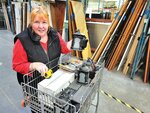

From early 20th Century thrift to building cabins from contractor cast-offs, reuse of building materials had long been an informal norm. But in a more recent world, entire houses have been thrown in the trash to make way for new construction. Landfills, many of them not lined to contain harmful chemicals, are filling up with construction debris, 90 percent of which is from demolition.
When James and Libby Wilson decided to open up their back porch, they wanted to pass along or recycle the materials. “We started the project, then realized we needed help,” said Libby. James is a carpenter and employee owner at Terra Firma, 2350 Territorial Road in the Midway. Terra Firma had worked with Better Futures Minnesota to salvage parts of houses they would remodel. “All our experiences with Better Futures have been positive,” James said. “There was no doubt who we were going to call when it came to our house. It’s great that there is such a considerate deconstruction and salvage operation in the Twin Cities.”
The crew took off exterior stucco and the siding underneath it plus ceiling and floor, leaving the structural elements. The Wilsons donated a cherry-colored wood cabinet that had been in the enclosed porch, to Better Futures’ ReUse Warehouse Store. Libby added, “We also love to come to the store. A dryer, a toilet, an old door…there’s lots of stuff we’ve bought from there in our four or so years of living here.”
Better Futures Minnesota at the ReUse Warehouse, 2620 Minnehaha Ave. in Minneapolis is among those trying to prevent and divert the construction waste stream through deconstruction, which serves reuse and recycling. Here’s how people and systems can help decrease waste.
Like the Wilsons, most consumers know home deconstruction from the store perspective, finding used appliances, cabinetry, or vintage hardwood flooring matching their urban 1900s to 1950s floors. Jason Allen, Waste Diversion Project Manager at Better Futures, said huge, hand-hewn old growth timbers also go quickly. “The uglier it is, the more demand there is for it,” Allen said. With work, these become fireplace mantels, furniture or art pieces.
How deconstruction works, and
where material goes
Deconstruction could mean anything from a “partial,” such as a kitchen remodel or condo where the wood color doesn’t fit the new owner’s taste, to a “full deconstruction,” an old house making way for something new. Deconstruction crews remove fixtures, cabinetry and appliances in the first pass. Flooring is removed, de-nailed and packaged on site. Good trim and built-ins are carefully removed. To access the structural lumber, plaster or drywall must come out, and that goes into a recycling dumpster along with wiring, siding and other parts to be sorted at a transfer station.
Better Futures’ crews consist of men leaving incarceration participating in a two-year voluntary workforce development program. They earn 12 different certifications including OSHA 10 accident-prevention training. They cross-train in the nonprofit’s other business lines of lawn-and-snow, janitorial, and appliance recycling. Crews have a supervisor and at least two experienced members, plus one or two trainees.
The donation of the reusable materials gives some homeowners a tax benefit that helps to offset the labor cost of dismantling the room, house or small commercial structure. Some projects in Ramsey, Washington, or Hennepin County will qualify for a deconstruction grant of up to $5,000 based on square footage of the home and tonnage of material reused.
There are no active landfills in Ramsey County, so careful decisions need to be made about where to send demolition waste from Saint Paul addresses. Ramsey County’s Solid Waste Management Master Plan 2018-2038, directs that 75% of construction waste should be diverted from landfills to reuse and recycling. Hennepin County’s Climate Action Plan, with a goal of 85% diversion, reports that only about 30% of construction waste is diverted.
For a list of reuse businesses which includes building materials, go to RamseyRecycles.com/reuse. There is a growing list of building materials reuse businesses on this Hennepin County website: https://www.hennepin.us/business/recycling-hazardous-waste/construction-demolition-waste or this statewide resource https://www.allforreuse.org/ecosystem-map
In addition to ReUse Warehouse, Habitat for Humanity’s ReStore at 2700 Minnehaha Ave. in Minneapolis accepts materials already removed by the homeowner or a contractor. They also carry furniture, paint, tools and smaller home improvement sundries. The proximity of the stores brings customers to both and presents a variety of goods. Habitat also has a ReStore in New Brighton at 510 County Road D West.
Future of deconstruction and reuse
Melissa Wenzel, the MPCA’s Built Environment Sustainability Administrator, has seen “movement, momentum, and more success stories” since joining this work in 2019. Ramsey and Washington County combined to offer deconstruction grants. Hennepin County has a similar program and Wenzel said two other metro counties have expressed significant interest in deconstruction projects and/or funding.
About policy and lawmaking, Wenzel said: “We’re already seeing cities that have sustainability, climate resiliency, waste management, emergency response, workforce development, and other similar goals. They are adopting more ‘sustainable built environment’ practices. St. Louis Park requires those receiving ‘green building’ funding to meet certain requirements: https://www.stlouisparkmn.gov/home/showpublisheddocument/23233/637902841408170000.
“We’re seeing more counties implement similar programs like Becker County’s Waste Diversion and Reuse Program and (Duluth area) WLSSD’s reuse program. Pope/Douglas and Dodge County’s future waste/material management campuses will include a building material and/or household goods reuse area.
“MPCA has a request in the governor’s budget to help fund similar programs at counties that do not currently have the financial means. We know there’s a high demand for deconstruction and building material reuse. We will continue to work to support this growing sustainable system,” Wenzel said. https://mn.gov/mmb-stat/documents/budget/2024-25-biennial-budget-books/governors-revised-march/pollution-control-agency.pdf
What can residents do to discourage demolition waste? Wenzel says use the systems and services that already exist. “Demand for these services will help drive them. USE used building materials. Items donated are often higher quality and lower cost than new items. Plus, you will likely own something far more unique than what you can find at big-box stores.” She hopes that cities and counties offer building material/tool/household goods swap days or donation days. “Definitely reach out to your local government contacts asking for these services. They WILL offer opportunities when enough people ask for them.”
Editor’s note: Margo Ashmore is Better Futures Minnesota’s Deconstruction Marketing and Business Development person, former owner of MSP Home Tour and former publisher of the Northeaster newspaper.
Comments
No comments on this item Please log in to comment by clicking here